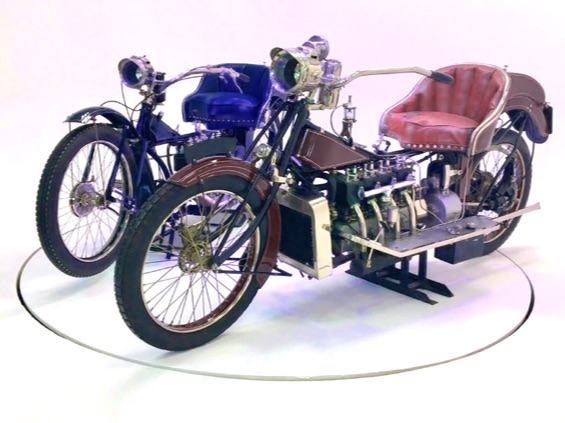Our Hall 2 photo studio/special exhibitions area currently contains are two Wilkinson machines.
Best known for making razor blades, many visitors don’t realise that Wilkinson also made some pretty spectacular motorcycles as follows.
1910 676cc Wilkinson TAC Series III
One of the most unusual motorcycles ever built, the Wilkinson was manufactured by an old-established London company best known for making swords and bayonets.
At the end of the nineteenth century, Wilkinson Sword began to diversify, making safety razors and high quality bicycles. After the factory moved from Chelsea to Acton, it ventured into making cars and motorcycles.
Early two-wheelers were powered by proprietary single- and twin-cylinder engines, but the Touring Auto Cycle (TAC) unveiled at the 1909 Stanley Show boasted an imposing four-cylinder unit.
As can be seen on this Series III TAC of 1910, the 676cc engine is set longitudinally in the cradle frame. It has automatic inlet valves with mechanically operated exhaust valves located below them. Drive from a three-speed gearbox and clutch goes to a worm drive at the rear wheel via a shaft with a universal joint.
Intended as a luxury vehicle, the TAC has a huge upholstered seat, footboards with car-type pedal controls and long handlebars for a relaxed riding posture. Some early Wilkinsons were even fitted with a steering wheel. For a comfortable ride on the rough roads of the day, front and rear suspension is by quarter-elliptic leaf springs.
Petrol is carried behind the seat, while a smaller tank behind the steering head holds engine oil. Priming cocks are provided so that the cylinders can be charged with neat fuel for cold starting.
This TAC, one of two known, was previously displayed at Wilkinson Sword’s Acton premises.
Engine
676cc (60 x 60mm) air-cooled in-line four, automatic inlet valves, side exhaust valves, Amac carburettor magneto ignition
Transmission
Single plate clutch, three-speed gearbox, shaft final drive
Chassis
Tubular cradle frame, leaf spring suspension front and rear, drum rear brake. Wheels: 26in

1912 848cc Wilkinson TMC Series V
Two years after launching the TAC, Wilkinson superseded it with the updated Touring Motor Cycle (TMC) for 1912. Retaining the ‘two-wheeled car’ character of its predecessor, the TMC has a water-cooled engine with a radiator mounted in the airstream behind the front wheel. The later unit has mechanically operated side inlet and exhaust valves and a longer stroke, raising cubic capacity to 848cc.
Other changes for 1912 include asbestos clutch linings in place of leather and a redesigned shaft drive with a crown and bevel arrangement at the wheel hub. Leaf springs were retained at the rear but front suspension was now by a more conventional Saxon braced fork. This machine has an auxiliary oil tank under the left footboard.
The Wilkinson rider must have needed a fair bit of practice to get used to the various controls. The pedal on the left footboard operates the clutch, while the two on the right bring on two separate sets of rear brake shoes. Engine speed is controlled by juggling the air and fuel levers on the right handlebar, a gearchange knob lies just in front of the seat nose and the plunger with a sight-glass ahead of that is for pumping oil to the engine. At least the prominent Jones speedometer is easy to see!
Wilkinson sold its motor vehicle business to Ogston Motor Co in 1914, which spelled the end for the two-wheelers. It is thought that no more than 250 fours were built and only six are known to survive.
Engine
848cc (60 x 70mm) water-cooled side-valve in-line four, Claudel-Hobson carburettor, coil ignition
Transmission
Single plate clutch, three-speed gearbox, shaft final drive
Chassis
Tubular cradle frame, telescopic fork front, leaf spring suspension front and rear, drum brake. Wheels: 26in




 Coventry Road
Coventry Road